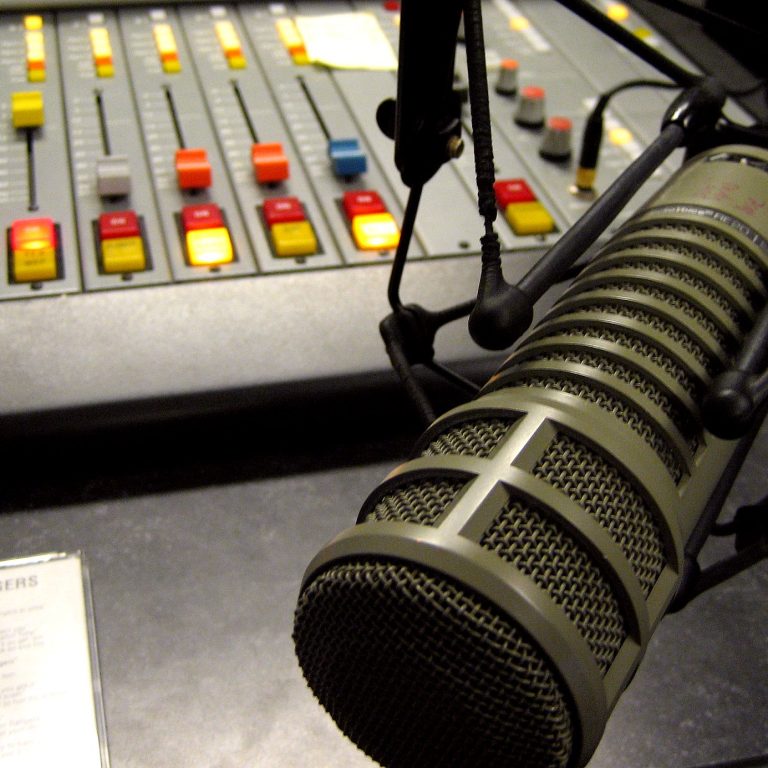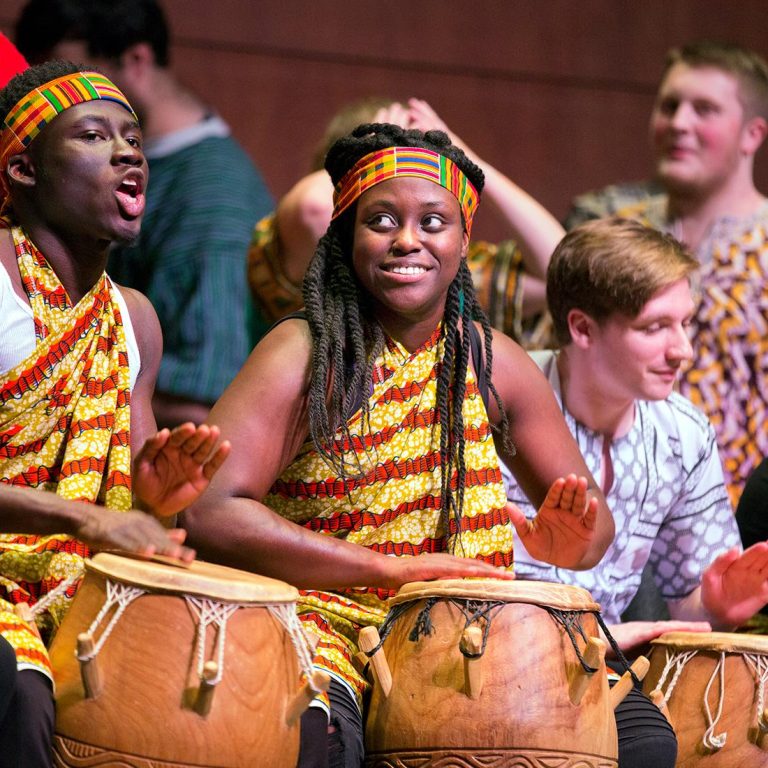Music works by using sound and rhythm to create patterns and organized sequences of notes and chords. It is made up of various elements such as melody, harmony, rhythm, and dynamics.
Melody: It is the main line of a song or a tune that is created by a sequence of notes played or sung one after another. Melodies are often memorable and provide a recognizable “hook” for listeners.
Harmony: It refers to the combination of different notes played or sung simultaneously to create chords. Harmony adds depth and enhances the emotional impact of the music.
Rhythm is the pattern of sound and silence in music. Rhythm gives music its groove and helps to establish a beat or pulse. It is created by the duration and spacing of notes and rests.
Dynamics: It refers to the volume and intensity of the music. Changes in dynamics add variations, contrast, and expression to a composition. For example, a loud section might convey excitement or intensity, while a soft section can create a feeling of intimacy or calm.
Music is typically written and composed using a musical notation system, such as sheet music or written lyrics with chord symbols. This notation allows musicians to read and interpret the written instructions, allowing them to accurately perform the music.

In contemporary music, technology and digital production techniques also play a significant role. Various instruments, effects, and software allow musicians and producers to create different sounds, manipulate recordings, and add layers to enhance the overall musical experience.
How do people experience music? People experience music in various ways, and it can have a profound impact on emotions, thoughts, and physical sensations. Here are some common ways in which people experience music:
1. Emotional Response: Music has the power to evoke strong emotions. It can make us feel happy, sad, nostalgic, excited, or calm. Different genres and styles of music can elicit different emotional responses in individuals.
2. Physical Sensations: Music can create physical sensations and reactions in the body. It can make us dance, tap our feet, or nod our heads to the beat. The vibrations from the sound can resonate within us and create a physical connection to the music.
3. Cognitive Stimulation: Music can stimulate cognitive processes and mental activity. It can enhance focus, concentration, and memory. Many people find that music helps them to think, study, or work more effectively.
4. Personal Connection: Music often holds personal significance and meaning for individuals. Certain songs or genres may remind them of specific events, people, or experiences in their lives. Music can provide comfort, solace, or inspiration and can also be an outlet for expressing and processing emotions.
5. Social Connection: Music is a universal language that brings people together. It can facilitate social bonding and create a sense of community. People attend concerts, sing in choirs, play in bands, or simply gather to listen to and appreciate music together.
6. Escapism and Entertainment: Music can transport us to different worlds and provide an escape from reality. It can be entertaining and serve as a form of leisure and enjoyment. People experience music subjectively, and the way they connect with and interpret it can vary greatly from person to person. It is a unique and personal experience that can have a profound impact on our lives.

Brief history of Music: The history of music is a vast and complex subject that dates back thousands of years. Here is a brief overview of key developments and periods in the history of music:
Ancient Music: The earliest known form of music dates back to prehistoric times, with evidence of musical instruments found in ancient caves. – Ancient civilizations such as Mesopotamia, Egypt, Greece, and Rome had rich musical traditions. Music played a significant role in religious ceremonies, entertainment, and social gatherings.
Medieval Music: From the fall of the Roman Empire in the 5th century to the 15th century, the medieval period saw the development of Western classical music. – Gregorian chant, a form of sacred vocal music, was widely practiced during this era. – Secular music, including troubadour songs and early forms of polyphony (multiple melodies sung or played simultaneously), started to emerge.
Renaissance Music: The Renaissance period (15th to 17th centuries) marked a rebirth of the arts and sciences, including music. Composers such as Josquin des Prez and Giovanni Palestrina created polyphonic choral music that emphasized clarity and expression. – Musical instruments continued to evolve and become more sophisticated.
Baroque Music: The Baroque era (17th to mid-18th centuries) is characterized by ornamentation, elaborate melodies, and rich harmonies. Prominent composers include Johann Sebastian Bach, George Frideric Handel, and Antonio Vivaldi. – The development of opera, orchestral music, and keyboard instruments significantly influenced this period.
Classical Music: The Classical era (mid-18th to early 19th centuries) is known for its balance, clarity, and formal structure. – Composers like Wolfgang Amadeus Mozart, Ludwig van Beethoven, and Franz Joseph Haydn produced symphonies, sonatas, and chamber music. The piano has become increasingly popular as a solo instrument.
Romantic Music: The Romantic period (19th century) emphasized individual expression, emotions, and experimentation. – Notable composers of this era include Ludwig van Beethoven, Franz Schubert, Frederic Chopin, and Richard Wagner. Orchestras grew in size and complexity, and a wider range of instruments was incorporated.
20th Century and Modern Music: The 20th century saw the rise of various musical movements, including Impressionism, Expressionism, Jazz, Blues, Rock, and Pop. – Composers like Igor Stravinsky, Claude Debussy, Arnold Schoenberg, and Karlheinz Stockhausen pushed the boundaries of traditional music. – Technological advancements led to electronic music, computer-based composition, and popular music genres continuing to evolve.
Today, music encompasses a vast array of styles, genres, and influences from different cultures worldwide, highlighting its dynamic nature and ongoing evolution throughout history.

The healing power of music has been recognized for centuries, but the exact mechanisms behind its effectiveness are not fully understood. However, several theories and explanations shed light on why music has a profound impact on our emotions, well-being, and even physical health.
Emotional and Psychological Effects: Music can evoke strong emotions and create a deep connection with listeners. It can trigger memories, inspire creativity, and promote self-expression. Listening to music activates the reward centers in the brain and releases dopamine, a neurotransmitter associated with pleasure and well-being.
Music has been shown to reduce stress, anxiety, and depression by promoting relaxation and providing an escape from negative thoughts and feelings. It can also serve as a powerful form of catharsis, allowing individuals to express and release emotions that may otherwise be challenging to articulate.
Physiological Effects: Music can influence heart rate, blood pressure, and respiration. Upbeat and stimulating music can increase heart rate and blood pressure, while slow, calming music can induce relaxation and lower these physiological responses.
Research has shown that music can reduce the perception of pain by stimulating the release of endorphins, the body’s natural painkillers.
Listening to music has been shown to enhance immune system function, lower levels of stress hormones, and improve sleep quality.
Neurological Effects: Neuroimaging studies have revealed that music activates various regions of the brain, including the auditory cortex, limbic system, and prefrontal cortex. Playing an instrument or engaging in active music-making activities can lead to changes in the brain’s structure and connectivity, promoting neuroplasticity and enhancing cognitive functions such as memory, attention, and problem-solving.
The synchronization of neural activity with the rhythm and structure of music may contribute to its motivational and emotional effects.
Social and Cultural Factors: Participating in music-making activities, such as singing in a choir or playing in a band, fosters social connections, a sense of belonging, and improved social skills. Music has a communal aspect that brings people together, promotes unity, and encourages shared experiences. It can facilitate communication and understanding across cultural, linguistic, and social boundaries.
While the exact mechanisms behind the healing power of music continue to be explored, it is evident that music has a profound impact on our emotions, well-being, and overall quality of life. It has the potential to enhance our physiological, psychological, and social states, making it a valuable tool for healing, therapy, and self-care.

The negative effects of music on the 20th century: While music has many positive effects, it also has some negative effects that can be seen in the 20th century. Here are some examples:
1. Promotion of destructive behavior: Some music genres, such as gangsta rap, heavy metal, and punk rock, promote and glorify drug use, violence, and misogyny. Many of these songs have lyrics that objectify women, glorify guns and violence, and encourage drug use, all of which can lead to negative behavior in listeners.
2. Misrepresenting gender roles: Popular music has often portrayed men and women in stereotyped roles, with male performers often portraying hyper-masculinity and women portrayed as hyper-sexualized objects of desire. This can hurt young listeners who may internalize these messages and adopt them as their own beliefs about gender roles.
3. Encouraging consumerism and materialism: Many modern popular songs are largely focused on material possessions, wealth, and consumerism. These messages can hurt the values and priorities of young listeners, leading to a focus on material goods rather than more meaningful aspects of life.
4. Copycat crimes: Some music and lyrics have been linked to copycat crimes, where listeners may emulate the violent or destructive behavior of the performers they admire. For example, some musicians have been accused of encouraging school shootings by promoting violent behavior and advocating for violence against others.
5. Exploitation of artists: The music industry has also been criticized for exploiting artists, taking advantage of their work and creativity while paying them little or no compensation. This can result in unethical and even illegal practices, such as record label monopolies and the non-payment of royalties to performers.
Overall, while music can have many positive effects, it is important to recognize that it can also have negative effects on individuals and society as a whole. As consumers of music, it is important to be aware of the messages being conveyed and to make informed decisions about the types of music we choose to listen to.
In conclusion, music is a complex musical form that uses sound and rhythm to create patterns and sequences of notes and chords that are designed to drive into the soul of the listener in either a positive or negative way, which is seen in the behavior of the individual. Music is a powerful tool in the hands of the creator that easily brings to fulfillment the desired goal.









